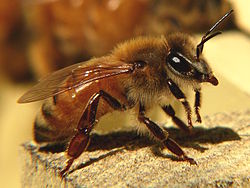Odour detection
Bees and wasps are trained using classical conditioning, being exposed to a particular odour and then rewarded with a sugar solution. [3] Within five minutes they learn to associate the smell with an impending supply of food and this triggers the proboscis extension reflex (sticking out their tongues). [4]
Trained hymenopterans have been shown to successfully detect explosive materials including TNT, Semtex, and C-4 as well as gunpowder and propellants. [3] [5] Wasps can be trained to detect the early signs of fungal disease on crops and may have medicinal value, identifying people with cancer just by being exposed to their breath. [6] Bees have been shown to detect and respond to more than 60 different odours including methamphetamine, uranium, and tuberculosis. They have been used to detect lung and skin cancers, diabetes, and to confirm pregnancy. [2] It is not known if they can detect potential seizures in humans.
Researchers at the University of Georgia have built a device named the "Wasp Hound" which contains the parasitic wasp species Microplitis croceipes . The insects normally walk around the PVC pipe in which they are housed but begin to migrate towards the source of an odour when it is the one that they were trained to recognise. These movements are tracked by a computer, with small cameras inside the device sending images for processing. Within 30 seconds of the wasps beginning to congregate near an odour source an alarm is sounded. [7]
This page is based on this
Wikipedia article Text is available under the
CC BY-SA 4.0 license; additional terms may apply.
Images, videos and audio are available under their respective licenses.
